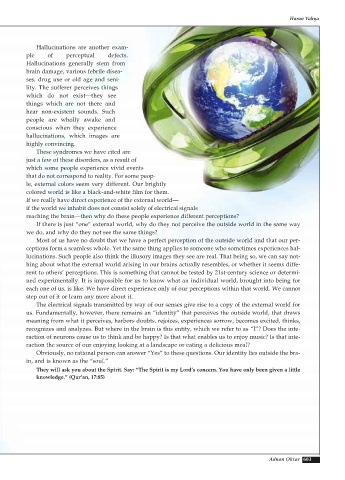Page 685 - Atlas of Creation Volume 4
P. 685
Harun Yahya
Hallucinations are another exam-
ple of perceptual defects.
Hallucinations generally stem from
brain damage, various febrile disea-
ses, drug use or old age and seni-
lity. The sufferer perceives things
which do not exist—they see
things which are not there and
hear non-existent sounds. Such
people are wholly awake and
conscious when they experience
hallucinations, which images are
highly convincing.
These syndromes we have cited are
just a few of these disorders, as a result of
which some people experience vivid events
that do not correspond to reality. For some peop-
le, external colors seem very different. Our brightly
colored world is like a black-and-white film for them.
If we really have direct experience of the external world—
if the world we inhabit does not consist solely of electrical signals
reaching the brain—then why do these people experience different perceptions?
If there is just “one” external world, why do they not perceive the outside world in the same way
we do, and why do they not see the same things?
Most of us have no doubt that we have a perfect perception of the outside world and that our per-
ceptions form a seamless whole. Yet the same thing applies to someone who sometimes experiences hal-
lucinations. Such people also think the illusory images they see are real. That being so, we can say not-
hing about what the external world arising in our brains actually resembles, or whether it seems diffe-
rent to others’ perceptions. This is something that cannot be tested by 21st-century science or determi-
ned experimentally. It is impossible for us to know what an individual world, brought into being for
each one of us, is like. We have direct experience only of our perceptions within that world. We cannot
step out of it or learn any more about it.
The electrical signals transmitted by way of our senses give rise to a copy of the external world for
us. Fundamentally, however, there remains an “identity” that perceives the outside world, that draws
meaning from what it perceives, harbors doubts, rejoices, experiences sorrow, becomes excited, thinks,
recognizes and analyzes. But where in the brain is this entity, which we refer to as “I”? Does the inte-
raction of neurons cause us to think and be happy? Is that what enables us to enjoy music? Is that inte-
raction the source of our enjoying looking at a landscape or eating a delicious meal?
Obviously, no rational person can answer “Yes” to these questions. Our identity lies outside the bra-
in, and is known as the “soul.”
They will ask you about the Spirit. Say: “The Spirit is my Lord’s concern. You have only been given a little
knowledge.” (Qur’an, 17:85)
Adnan Oktar 683

